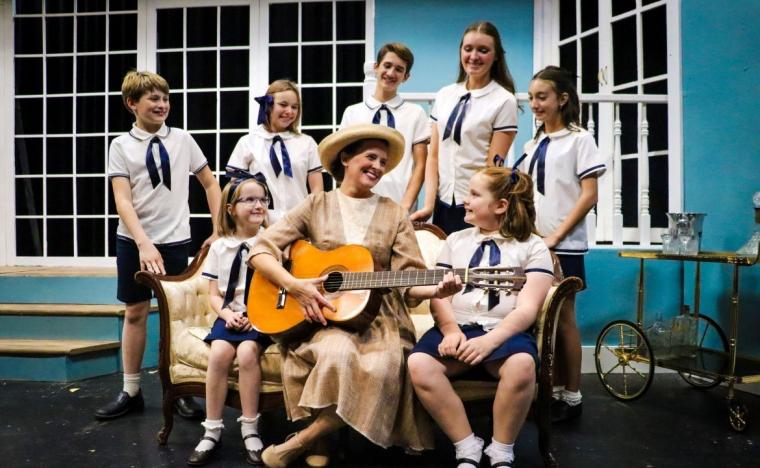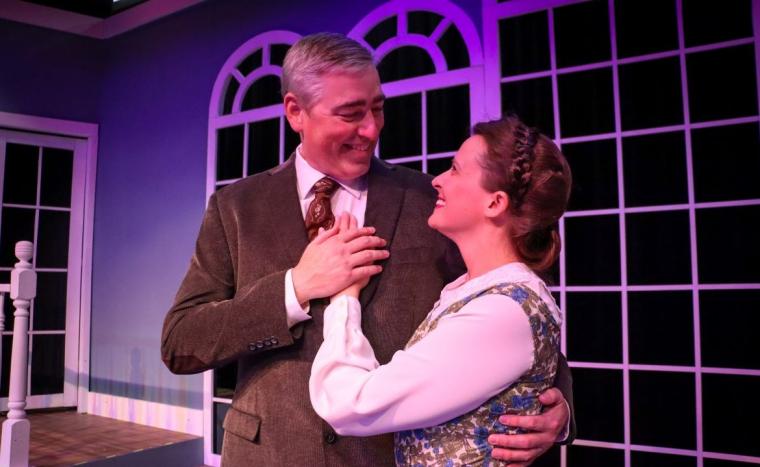
Sarah Lounsberry and the vion Trapp children in The Sound of Music
It’s very likely you’re already familiar with the plot of the beloved musical The Sound of Music, currently playing on the Quad City Music Guild's Prospect Park Auditorium stage.
If you’re not, Mother Abbess (the powerful Erin Platt) sends Maria (a pleasant Sarah Lounsberry), a young postulant who doesn’t quite fit in with the other nuns, to work for the former naval captain and widower Georg von Trapp (the dashing Nathan Bates) as the governess for his seven children. All of this is set in the precarious time just before Austria is overtaken by the Nazis, which gives the production an added layer of tension, even in its lighter moments. However, if you’re familiar with this story because of the 1965 feature film starring Dame Julie Andrews, consider this your fair warning: On stage, Rodgers' and Hammerstein's The Sound of Music is a bit different than the movie.
The good news is that the musical’s storyline is just the same. The slightly more confusing news, at least for several patrons I overheard at Saturday evening’s performance, is that the stage version has some songs appearing in different places than you may remember, and there are even a few songs you may not have heard before. A handful of transitions also land a little differently on stage, which can take a moment to adjust to if the classic film is your primary Sound of Music reference point. Luckily, if you’re willing to be a little flexible, director David Blakely’s production is most enjoyable overall.

In fact, I think one of the strengths of this stage version is that Baroness Elsa Schraeder (the hilariously expressive Jen Sondgeroth) is allowed to display a little more depth and substance. It’s too easy to cast her strictly as a villain. (Spoiler alert: The true villains are the Nazis.) One of the stage version's songs that doesn’t appear in the movie is “How Can Love Survive,” a rather witty-and-funny number that gives both Elsa and Max (Kirsten Myers) a chance to shine, and boy do these two add some real personality to the show. Their scenes help balance out the more earnest moments and give the production some welcome sophistication and humor. It’s also interesting to see that Elsa and Georg don’t just end their relationship because of Maria. Rather, it’s their political opinions that are the catalyst, as noted in the second song with which you may not be familiar, “There’s No Way to Stop It.”
Who doesn’t love to fawn over the von Trapp children? Blakely’s cast gives us no reason not to. Liesl (Marissa Pedersen), Friedrich (Eli Schroeder), Louisa (Selah Fitzen Etzel), Kurt (Jack Lounsberry), Brigitta (Mariana Karfis), Marta (Gracie Cross), and little Gretl (Edith Young) are collectively adorable, eliciting “Awww”s from the crowd whenever they’re on stage. Music director Mark Swessinger and assistant Deb Swift have these kiddos singing beautifully from the classic “Do-Re-Mi” to “So Long, Farewell.” Whenever the von Trapp children were performing, there was an electric energy abounding in the auditorium that reminded me just how timeless and endearing this musical score truly is.
Did it bother me that Liesl’s shoes were inexplicably a dissimilar color from the rest of the children’s? It did, because why bother with uniforms if they aren’t going to be … uniform? But aside from the tan shoes and the priest’s not-so-liturgically-correct blue chasuble, costume designer Susan Woodard’s work was otherwise quite lovely. With a full cast of 44, that’s no small feat, and her collective wardrobe choices manage to give the show a polished, cohesive look. I especially loved all the ballgowns and Maria’s dress when she returns to the von Trapp home. And a shout-out to Kevin Pieper’s set design, because the home felt elegant and thoughtfully constructed, delivering a stunning backdrop. Also visually remarkable is the Austrian mountain backdrop as painted by Bill and Cathy Marsoun, which was simply gorgeous.

It must be difficult to work on a show that is so very well known, with audience members likely coming in with expectations, so major kudos to choreographer Sara Laufer, because the Landler – the traditional folk dance primarily danced by Maria and the Captain – was quite delightful and beautifully employed the stage space. Laufer’s choreography otherwise was fairly simple, but that simplicity served the cast well. The kids didn’t have to worry about complicated dance steps while singing, and that allowed them to stay audibly strong throughout the whole piece. The overall effect is a production that feels heartfelt, polished, and warmly familiar, despite a few alterations from the beloved film.
The Sound of Music may or may not be on your own personal list of “Favorite Things,” but this production – with its live pit band, huge cast, and a whole lot of talent – is an absolute treat on stage. Do I still wish “The Lonely Goatherd” employed puppets instead of pajamas? Absolutely. That doesn’t make this Quad City Music Guild production any less special.
Quad City Music Guild's The Sound of Music runs as the Prospect Park Auditorium (1584 34th Avenue, Moline IL) through November 23, and more information and tickets are available by calling (309)762-6610 and visiting QCMusicGuild.com.










